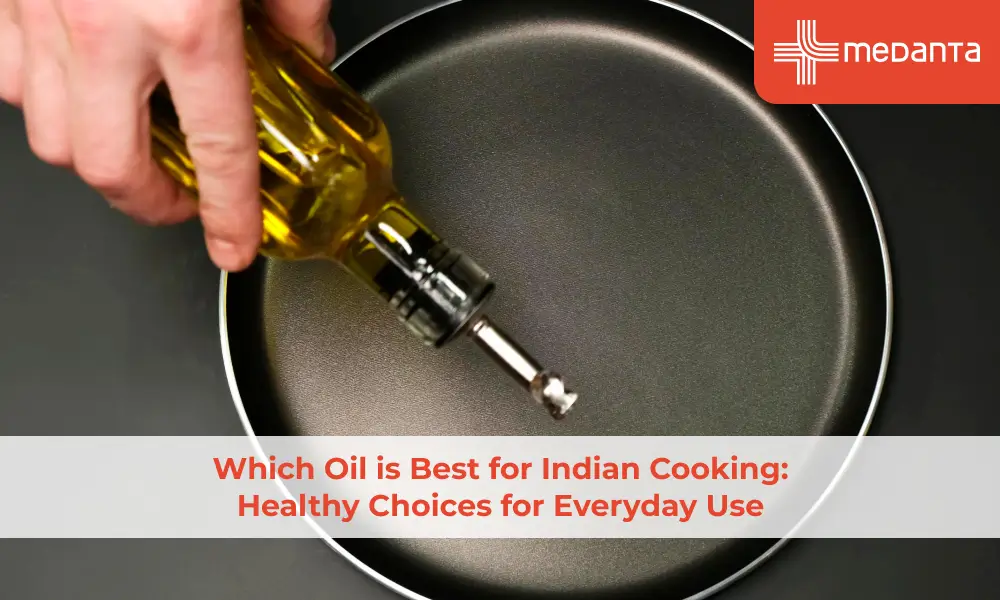Which Oil is Best for Indian Cooking: Healthy Choices for Everyday Use

TABLE OF CONTENTS
Heart disease affects more people worldwide than any other condition, and its numbers are growing faster in developing countries like India. The type of cooking oil you use every day can make a big difference to your heart's health. Indian cooking often heats oils to very high temperatures above 170°C during deep frying, which makes picking the right heart-friendly oil even more important.
This article helps you pick the healthiest cooking oils for your Indian kitchen. Readers will also learn about their nutritional benefits and which oil works best for different cooking styles. The right oil choice can help protect your family's health, whether you're frying, tempering spices, or making curry.
Nutritional Value of Common Cooking Oils in India
Each cooking oil comes with its own nutritional profile thus play a key role in Indian cuisine. Each oil contains different proportions of fats—saturated, monounsaturated (MUFA) and polyunsaturated (PUFA)—along with antioxidants and micronutrients.
According to nutrition experts not every cooking oil can handle the high heat required by Indian cooking methods. People who use mustard oil to fry their food have a 71% lower risk of heart disease compared to those using sunflower oil. Healthy fats in these oils come loaded with antioxidants that shield cells from harm. Indian cooking's top picks include mustard oil, which rates 9/10 due to its high levels of monounsaturated fats and omega-3s. It stays stable even at high temperatures. Ghee ranks 8/10 and gives you vitamins A and D along with great taste. Rice bran oil and coconut oil are also smart picks because they can take the heat while offering health benefits.
Top Healthy Oils for Indian Cooking
The Best Oils for Indian cooking conditions including but not limited to:
Oil Type | Benefits | Smoke Point |
Ghee | Rich in fat-soluble vitamins A, D, E, and K. Boosts immunity and digestion. Contains butyrate for gut health. | 250°C |
Mustard Oil | Excellent omega-6 to omega-3 ratio. Contains anti-inflammatory compounds & reduces heart disease risk by a lot. | 250°C |
Coconut Oil | Rich in medium-chain triglycerides (MCTs) for quick energy. Supports brain and gut health. | Virgin: 175°C, Refined: 230°C |
Sesame Oil | Packed with antioxidants and vitamin E. Supports joint and skin health. | Unrefined: 177°C, Refined: 232°C |
Groundnut Oil | Contains healthy fats and plant sterols that reduce cholesterol. Heart-friendly when used moderately. | 232-235°C |
Olive Oil | Rich in monounsaturated fats and antioxidants. Best for low-heat cooking. | Extra Virgin: 190°C, Refined: 240°C |
How do I Know Which Oil is Best For Me?

Figuring out which oil will work best for you? It all depends on the way you cook your food. Oils with higher smoke points (mustard oil, ghee or refined groundnut oil) are best when you are cooking under high temperature (above 170°C). These oils stay stable and do not break down into harmful compounds.
Canola oil, sunflower oil and peanut oil can be your choice for sautéing or stir frying. Cold-pressed oils like extra virgin olive oil add nutrients and flavour to salad dressings.
Oil blending creates a balanced fatty acid profile that combines different oils' strengths and boosts oxidative stability and nutritional benefits. Research shows a rice bran & safflower oil blend (in the seventy-thirty ratio) improves lipid parameters and reduces inflammatory markers.
Tips for Using Oils in the Indian Diet for Heart and Weight Health
Your choice of cooking oils substantially impacts heart health. Doctors suggest you to hop from one oil to other rather than sticking to just one. Each oil's unique nutritional profile can benefit your health in different ways.
Cold-pressed varieties preserve 30-40% more nutrients and antioxidants compared to refined oils. Indian kitchens' high-temperature cooking needs oils with higher smoke points. Ghee, coconut oil or groundnut oil works best in these situations.
Reusing or reheating cooking oils, particularly after deep frying, creates harmful trans fats and dangerous compounds. Your oils need proper storage in cool, dark places with tightly sealed containers that prevent them from turning rancid.
Moderate oil consumption helps manage weight since all oils pack plenty of calories. If used properly olive, coconut and sesame oils can be your trusted partner in your weight loss journey. Olive oil's monounsaturated fats help you control cholesterol levels and maintain a healthy weight.
Blending different oils enhances their nutritional balance. Rice bran and safflower oil combinations show remarkable improvements in lipid profiles and inflammation markers. Canola-flaxseed oil mixes also reduce serum cholesterol levels effectively.
Your heart health depends on avoiding vanaspati, hydrogenated oils, and products with trans fats. These substances substantially increase your risk of heart disease.
Conclusion
Healthy Indian cooking starts with picking the right oil. The oil you pick should match your cooking method. Oils with higher smoke points like ghee or mustard oil work best for high-temperature cooking. Olive or sesame oil pairs well with lighter cooking techniques.
Your body benefits most when you switch between several healthy oils. Each type brings its own nutritional benefits to the table. When you mix them, the blended oils have boosted health benefits - studies show that mixing rice bran with safflower oil helps improve heart health markers.
Whatever oil you choose, use it in moderation. Even the healthiest oils are calorie-dense, so watching portions helps both your heart and waistline. These insights will help you make better choices that keep your family healthy while enjoying flavour of traditional cooking.
FAQs
Which oil is best for daily Indian cooking?
Mustard oil proves excellent for everyday Indian cooking. Its heart-friendly omega-6 to omega-3 ratio makes it a smart choice. You can also rotate between groundnut oil, rice bran oil, and ghee to get balanced nutrition.
A blend of rice bran and safflower oil (70:30) helps improve lipid parameters and cuts down inflammation.
Can olive oil be used for Indian cooking?
Yes, it can—but you need to choose wisely. Regular olive oil (not extra virgin) works well up to 240°C and suits medium-heat Indian cooking. Extra virgin olive oil works best when you finish dishes or do light sautéing.
Is coconut oil good for daily use in India?
Coconut oil works great! It contains medium-chain triglycerides (gives quick energy). Its high smoke point makes it ideal for South Indian cuisine, especially with curries and fried seafood.
Which oil is best for frying and deep cooking?
Oils with high smoke points work best here: ghee (250°C), mustard oil (250°C), and groundnut oil (232°C). These oils stay stable without breaking down into harmful compounds.
How much cooking oil should I use for health?
Limit your daily oil intake to two to three teaspoons (10-15ml) per person. Measuring spoons help control portions while cooking.
Which is better - traditional oils like sesame or modern oils?
Traditional Indian oils perform better than modern refined varieties. Cold-pressed traditional oils keep essential nutrients that get lost in refining processes. According to various research, ghee, coconut and mustard oil remain healthier under Indian cooking conditions.





